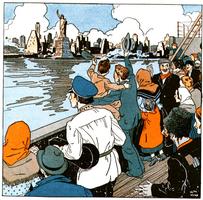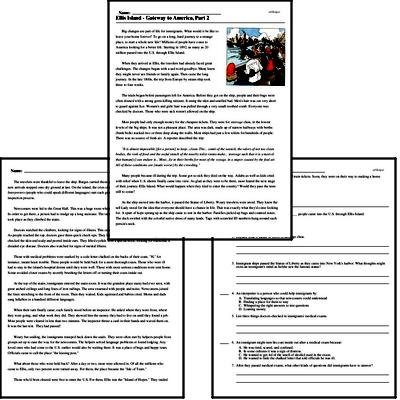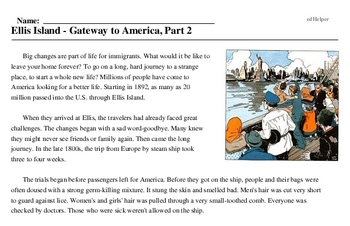Ellis Island - Gateway to America, Part 2
Big changes are part of life for immigrants. What would it be like to leave your home forever? To go on a long, hard journey to a strange place, to start a whole new life? Millions of people have come to America looking for a better life. Starting in 1892, as many as 20 million passed into the U.S. through Ellis Island.
When they arrived at Ellis, the travelers had already faced great challenges. The changes began with a sad word-goodbye. Many knew they might never see friends or family again. Then came the long journey. In the late 1800s, the trip from Europe by steam ship took three to four weeks.
The trials began before passengers left for America. Before they got on the ship, people and their bags were often doused with a strong germ-killing mixture. It stung the skin and smelled bad. Men's hair was cut very short to guard against lice. Women's and girls' hair was pulled through a very small-toothed comb. Everyone was checked by doctors. Those who were sick weren't allowed on the ship.
Most people had only enough money for the cheapest tickets. They were for steerage class, in the lowest levels of the big ships. It was not a pleasant place. The area was dark, made up of narrow hallways with berths (bunk beds) stacked two or three deep along the walls. Most ships had just a few toilets for hundreds of people. There was no source of fresh air. A reporter described the trip:
"It is almost impossible [for a person] to keep...clean. The... vomit of the seasick, the odors of not too clean bodies, the reek of food and the awful stench of the nearby toilet rooms make... steerage such that it is a marvel that human[s] can endure it... Most...lie in their berths for most of the voyage, in a stupor caused by the foul air. All of these conditions are [made worse] by the crowding."
Many people became ill during the trip. Some got so sick they died on the way. Adults as well as kids cried with relief when U.S. shores finally came into view. As glad as they were to be there, most feared the next stage of their journey-Ellis Island. What would happen when they tried to enter the country? Would they pass the tests still to come?
As the ship moved into the harbor, it passed the Statue of Liberty. Weary travelers were awed. They knew the tall Lady stood for the idea that everyone should have a chance in life. That was exactly what they'd come looking for. A spurt of hope sprang up as the ship came to rest in the harbor. Families picked up bags and counted noses. The deck swirled with the colorful native dress of many lands. Tags with scrawled ID numbers hung around each person's neck.
The travelers were thankful to leave the ship. Barges carried them toward the tall buildings of Ellis Island. The new arrivals stepped onto dry ground at last. On the island, the cries of many different tongues rang in the air. Interpreters (people who could speak different languages) met each group. They guided the travelers through the inspection process.
Newcomers were led to the Great Hall. This was a huge room where most of the inspection process took place. In order to get there, a person had to trudge up a long staircase. The travelers didn't know it, but their first test took place as they climbed the stairs.



